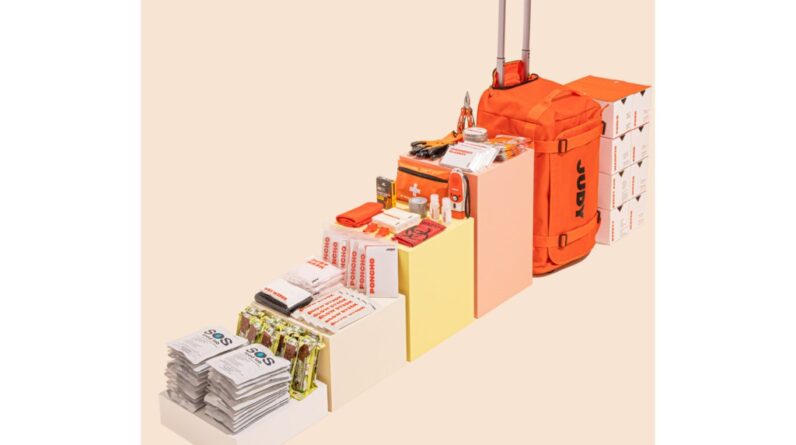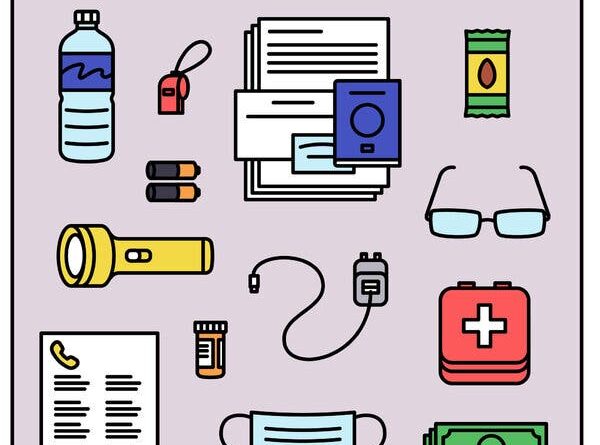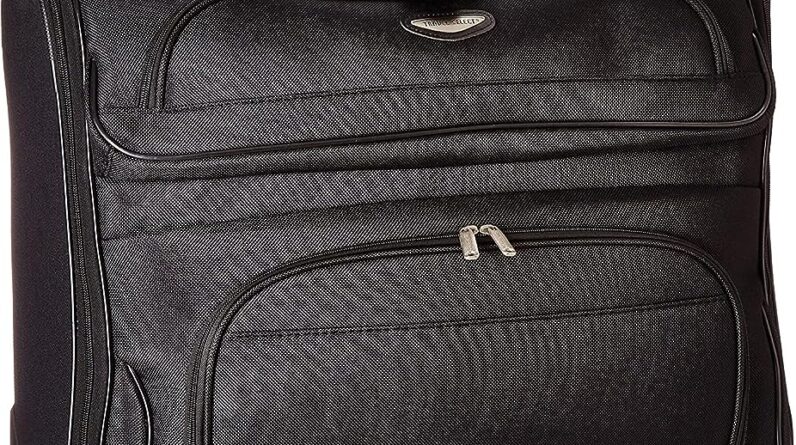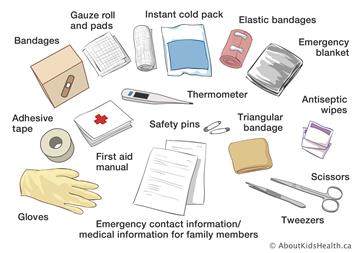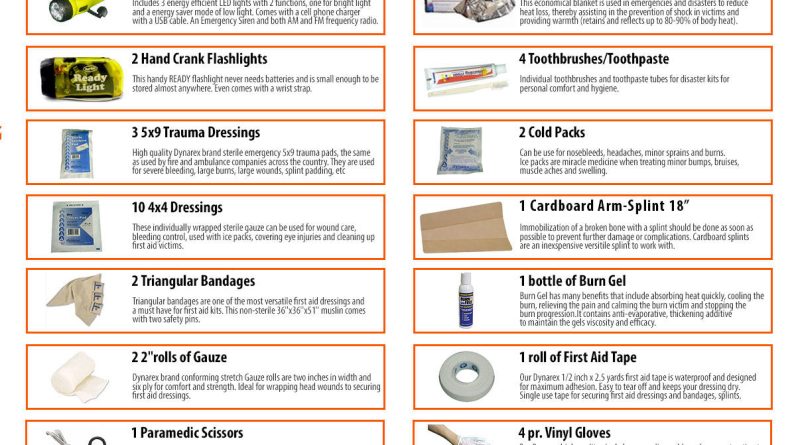
Are you in need of an emergency kit but feeling overwhelmed by the numerous options available? Look no further! In this article, we will provide you with valuable tips on how to evaluate and select the perfect emergency kit that caters to your specific requirements. No more stress or confusion – we’ve got you covered. Let’s get started on finding the ideal emergency kit for you!

This image is property of cdn.shopify.com.
Factors to Consider
When selecting the perfect emergency kit for your needs, there are several important factors to consider. These factors will help ensure that your emergency kit is tailored to your specific requirements and will serve you well in times of crisis. Here are the key factors you should keep in mind:
Location
The first factor to consider is your location. Different regions have different types of emergencies that are more common. For example, if you live in an area prone to hurricanes, you’ll want an emergency kit that includes items specifically designed for hurricane preparedness, such as plywood for boarding up windows. On the other hand, if you live in an area prone to earthquakes, your emergency kit should focus on items like sturdy shelving units to prevent items from falling and causing injuries.
Duration
The next factor to consider is the duration for which you want your emergency kit to sustain you. Are you looking for a kit that will last for just a few days until help arrives, or do you want a kit that can provide for you and your family for an extended period of time? The duration will determine the quantity of supplies you need, including food, water, and other essential items.
Number of People
The number of people in your household or group is another important consideration. Your emergency kit should be able to provide for the needs of all individuals, including food, water, and other necessary supplies. It’s vital to ensure that your kit is appropriately sized to accommodate everyone’s needs.
Special Needs
If you or any members of your household have special needs, such as medical conditions or disabilities, it’s crucial to consider this when choosing an emergency kit. You may require additional supplies like medications, medical equipment, or personalized emergency plans. Make sure that your emergency kit meets these specific requirements.
Budget
Lastly, your budget plays a significant role in selecting the right emergency kit for your needs. Determine how much you are willing to spend and shop accordingly. Keep in mind that while it’s essential to find a kit that fits your budget, compromising on quality and essential items may not be wise. Strike a balance between cost-effectiveness and meeting your requirements.
Essential Items
Now that you have considered the key factors when choosing an emergency kit, it’s time to delve into the essential items that should be included. These items are crucial for your survival and well-being during an emergency situation. Here are the main categories of essential items that you should prioritize:
Food and Water
An emergency kit should contain an ample supply of non-perishable food items that are easy to prepare and provide sufficient nutrition. Consider including items like canned goods, energy bars, and dehydrated meals. Additionally, stock up on an adequate supply of bottled water or invest in a water filtration system to ensure access to clean drinking water.
First Aid Supplies
A well-stocked first aid kit is essential in any emergency situation. It should include a variety of bandages, antiseptic ointments, pain relievers, disinfectants, and other basic medical supplies. Customize your kit based on any specific medical conditions or needs within your household. Don’t forget to regularly check the expiration dates of the contents and replenish as needed.
Emergency Communication
Maintaining communication during an emergency is vital for receiving updates and seeking assistance. Include a battery-powered radio in your emergency kit to stay informed about the situation. Additionally, invest in a cell phone charger that can be powered using alternative energy sources like solar power or hand crank. An emergency whistle is also valuable for signaling for help.
Lighting and Power
When the power goes out, having a reliable source of lighting is crucial. Include flashlights with spare batteries in your emergency kit, ensuring that they are within easy reach. Emergency candles are also a good addition, offering a long-lasting light source. Consider investing in a solar power charger or a portable generator to keep essential devices charged during an extended emergency.
Warmth and Shelter
In emergency situations, it’s important to have provisions for warmth and shelter. Emergency blankets are compact and lightweight, providing insulation and protection from the elements. Tents or tarps can serve as temporary shelters if you need to evacuate or if your home becomes uninhabitable. Hand warmers can provide relief in cold weather, ensuring your comfort and well-being.
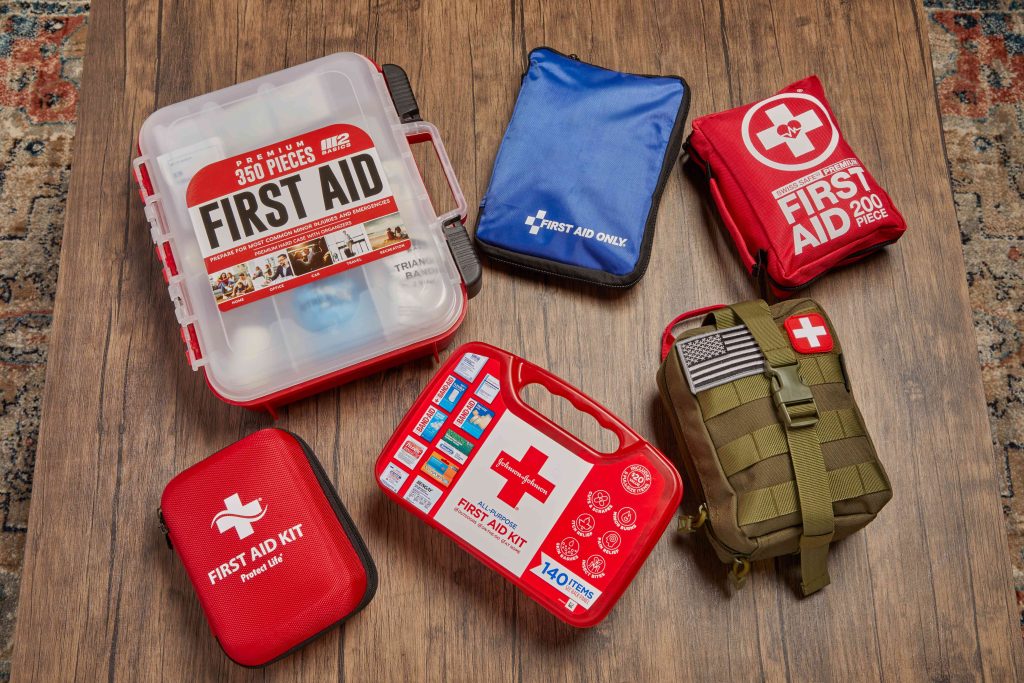
This image is property of www.health.com.
Food and Water
When it comes to food and water in your emergency kit, there are several factors to consider to ensure you are well-prepared and sustained throughout the crisis. Here are some key points to keep in mind:
Calorie Requirements
During an emergency, it’s important to have enough calories to sustain your energy levels. Your emergency food supply should provide an adequate amount of calories per day for each individual. The average adult requires approximately 2,000 to 2,500 calories per day, but this can vary based on factors such as age, gender, and activity level.
Long Shelf Life
Choose non-perishable food items with a long shelf life. Canned goods, protein bars, and dehydrated meals are excellent choices as they can last for extended periods without spoiling. Pay attention to expiration dates and rotate your supplies periodically to ensure you always have fresh items on hand.
Water Filtration
Water is essential for survival, and having access to clean drinking water during an emergency is paramount. Consider investing in a water filtration system that can remove contaminants and make any water source safe to drink. Portable water filters or water purification tablets can be compact and effective options to include in your emergency kit.
Cooking and Eating Utensils
Don’t forget the necessary utensils for food preparation and consumption. Include lightweight cooking utensils such as a portable stove, pots, and pans. Additionally, pack disposable plates, cups, and cutlery to minimize cleanup and conserve water. A multi-tool can also come in handy for various tasks, including opening cans and bottles.
First Aid Supplies
A well-stocked first aid kit is essential in any emergency situation. It can mean the difference between a minor injury and a more severe one. Here are the key aspects to consider when assembling your first aid kit:
Basic First Aid Kit
Start with a basic first aid kit that includes essential items such as bandages, gauze pads, adhesive tape, antiseptic wipes, and scissors. These supplies can be used to treat minor cuts, scrapes, and burns. Include splints and elastic bandages for potential fractures or sprains. A comprehensive first aid manual should also be included to guide you through various medical emergencies.
Prescription Medications
If you or any members of your household require prescription medications, it’s critical to have an adequate supply in your emergency kit. Speak to your healthcare provider about obtaining an extra prescription refill for emergency use. Rotate these medications regularly to prevent them from expiring.
Specialty Items
Consider any specific medical conditions or needs within your household. Include items such as EpiPens for severe allergies, asthma inhalers, insulin for diabetics, or any other essential medical supplies specific to your situation. It’s crucial to have these items readily available during an emergency.
Manuals and Guides
Even with basic first aid knowledge, it’s always helpful to have additional resources on hand. Include manuals or guides that provide instructions for administering first aid, recognizing symptoms of common illnesses, or other medical emergencies. These materials can be invaluable in assisting you or others in the event of an injury or illness.
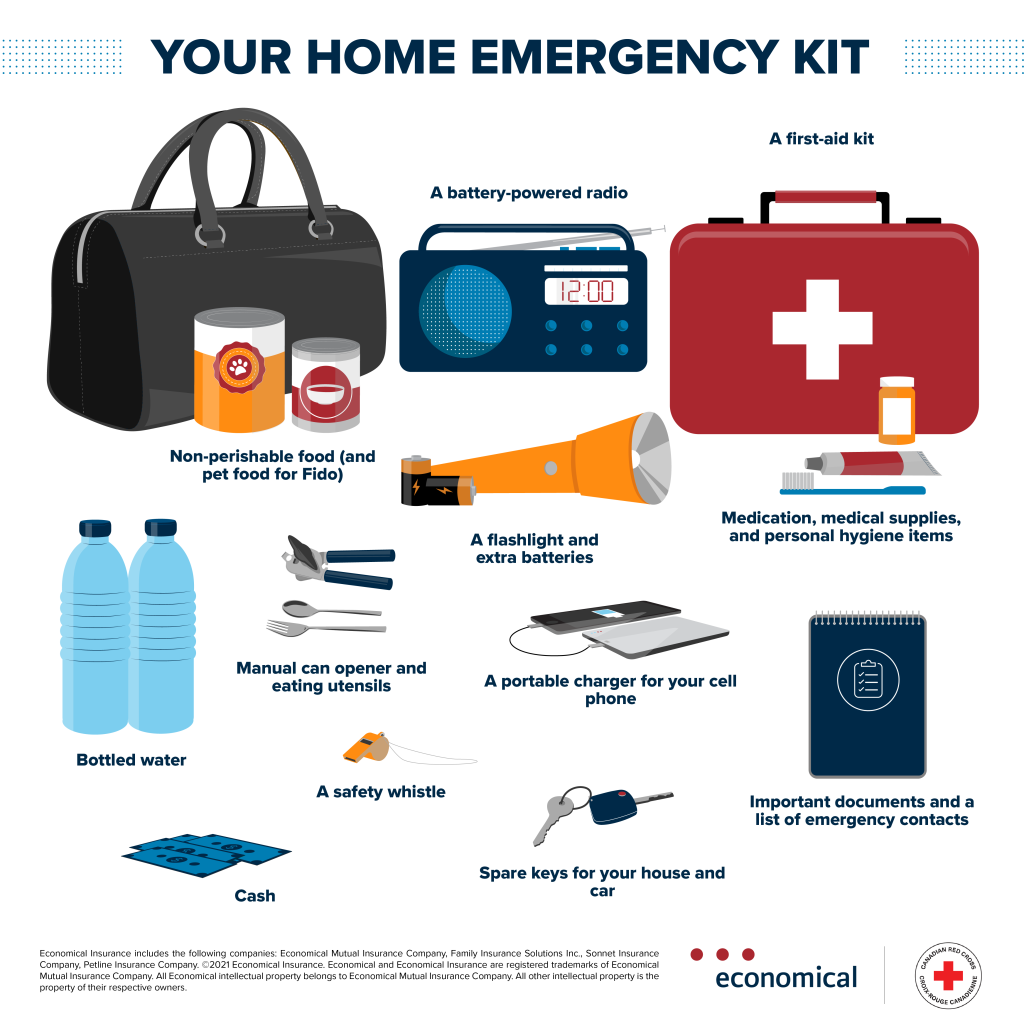
This image is property of www.economical.com.
Emergency Communication
In any emergency situation, the ability to communicate is vital. Whether it’s staying informed or seeking help, having the necessary tools for communication is crucial. Consider the following items when preparing your emergency communication kit:
Battery-Powered Radio
A battery-powered radio is an essential communication device during emergencies. It allows you to stay up-to-date on the latest news, weather warnings, and emergency instructions. Ensure your emergency kit includes spare batteries for the radio and regularly check the expiration dates.
Cell Phone Charger
In today’s digital age, a cell phone is often our lifeline to the outside world. Include a cell phone charger in your emergency kit that can be powered using alternative energy sources such as solar power or hand crank. This will allow you to charge your phone even when the electricity is down.
Emergency Whistle
An emergency whistle is a small, lightweight device that can be incredibly useful for attracting attention and signaling for help. Keep a whistle on your keychain or attach it to your emergency kit to ensure it’s readily accessible in case of need.
List of Emergency Contacts
Compile a list of important emergency contacts and include it in your communication kit. This list should include the numbers of family members, friends, neighbors, and any local emergency services. It’s important to have this information readily available, especially if your cell phone is not accessible or out of battery.
Lighting and Power
During an emergency, reliable and efficient lighting and power sources are crucial for maintaining visibility and powering essential devices. Consider the following aspects when assembling your lighting and power kit:
Flashlights and Batteries
Flashlights are a must-have in any emergency situation. Include sturdy and reliable flashlights in your emergency kit, ensuring that everyone in your household has access to one. Pack spare batteries and regularly check their expiration dates to keep them functional.
Emergency Candles
Emergency candles are a great addition to your lighting kit as they provide a long-lasting light source. Look for candles designed for emergencies that are longer burning and less likely to tip over. Additionally, include a lighter or waterproof matches to easily light the candles.
Solar Power Charger
Investing in a solar power charger can be a game-changer during a prolonged power outage. These portable chargers harness solar energy to recharge your electronic devices such as cell phones, tablets, or portable radios. Look for durable and efficient models that suit your power needs and can be easily stowed in your emergency kit.
Portable Generator
For long-term power needs during an emergency, consider including a portable generator in your emergency kit. These devices can provide electricity to power essential appliances, medical equipment, or keep lights and communication devices running. Ensure that you have the necessary fuel and follow safety guidelines for operating the generator.
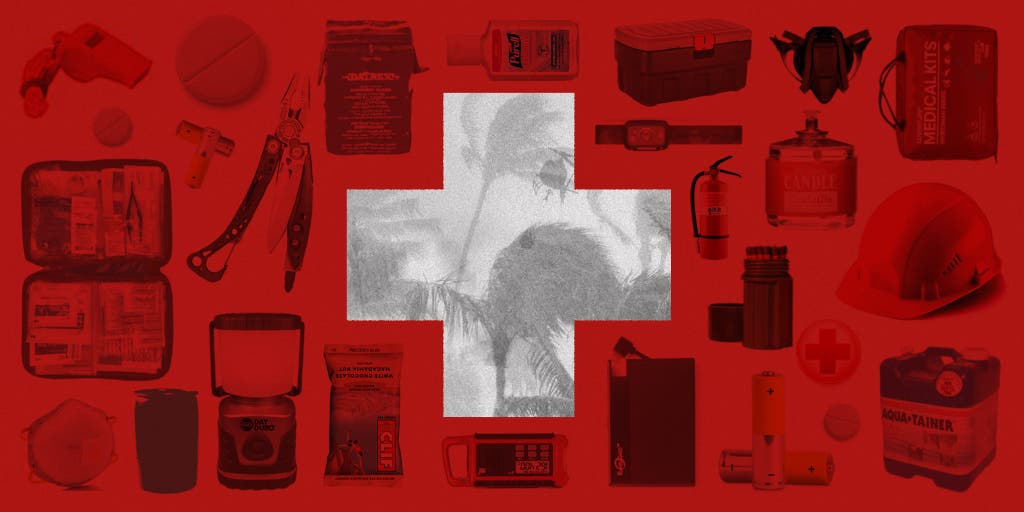
This image is property of cdn.thewirecutter.com.
Warmth and Shelter
In an emergency, maintaining warmth and having adequate shelter is crucial for your well-being and survival. Consider the following factors when selecting items for your warmth and shelter kit:
Emergency Blankets
Emergency blankets, also known as space blankets, are lightweight, compact, and designed to provide insulation in emergency situations. These blankets reflect and retain body heat, keeping you warm in cold conditions. Include several emergency blankets in your emergency kit, ensuring that each member of your household has their own.
Tents or Tarps
Having a reliable shelter option in your emergency kit is essential, especially if evacuation or displacement becomes necessary. Pack lightweight tents or tarps that can be quickly assembled to provide protection from the elements. Look for models that are waterproof and durable, capable of withstanding rough conditions.
Hand Warmers
Hand warmers are small packets that generate heat when exposed to air. These simple yet effective devices can provide comfort and warmth in cold weather. Include several hand warmers in your emergency kit to ensure that your extremities stay warm and prevent frostbite or hypothermia.
Waterproof Matches
In emergency situations, having the ability to start a fire is crucial for warmth, cooking, and boiling water for purification. Include waterproof matches in your emergency kit to ensure you can start a fire even in damp or wet conditions. Store the matches in a waterproof container to protect them from moisture.
Additional Tools and Equipment
Alongside the essential items for survival, there are several additional tools and equipment that can prove invaluable in emergency situations. Consider these items when assembling your emergency kit:
Multi-Tool
A multi-tool is a versatile tool that combines multiple functions in one compact package. It typically includes features such as pliers, knives, screwdrivers, wire cutters, and more. Having a multi-tool in your emergency kit can provide you with various tools in one convenient device.
Duct Tape
Duct tape is a simple yet versatile tool that can be used for a multitude of emergency repairs. It can be used to seal leaks, repair equipment, create temporary shelters, or secure items together. Include a roll of duct tape in your emergency kit to ensure that you are prepared for any on-the-spot fixes.
Fire Extinguisher
In case of a small fire outbreak, having a fire extinguisher can help prevent it from spreading and potentially causing further damage. Invest in a compact and readily accessible fire extinguisher that is suitable for household use. Make sure all members of your household are familiar with its operation.
Cash and Important Documents
In an emergency situation, access to cash and important documents can be crucial. Include a small amount of cash in your emergency kit as ATMs and credit card transactions may not be accessible. Store important documents such as identification papers, insurance policies, and contact information in a waterproof and portable document holder.
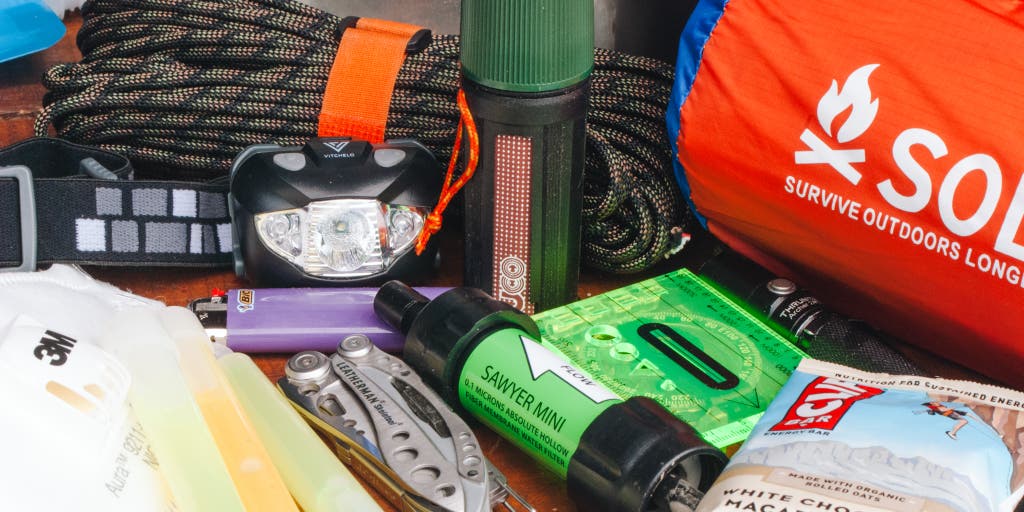
This image is property of cdn.thewirecutter.com.
Ease of Storage and Portability
When it comes to emergency kits, storage and portability are critical aspects to consider. Here are the key factors to keep in mind for convenience and ease of use:
Compact and Lightweight
Your emergency kit should be compact and lightweight, making it easy to store and transport. Choose items that are both space-efficient and lightweight without compromising functionality and durability. This will ensure that your kit can be easily grabbed and carried in case you need to evacuate.
Waterproof and Durable
Invest in waterproof and durable containers or bags to store your emergency kit contents. This will protect the items from moisture and ensure they remain in optimal condition. Consider using waterproof containers or sealing items in waterproof bags to prevent damage.
Grab-and-Go Design
In emergency situations, time is often of the essence. Opt for an emergency kit that has a grab-and-go design, allowing you to quickly access all the necessary items. Arrange your kit in a way that the most critical items are easily accessible and visible.
Storage Space
Ensure that you have adequate storage space for your emergency kit. Identify a designated area in your home where the kit can be stored, preferably in a cool, dry, and easily accessible location. Regularly check your supplies, replenishing any items that have expired or been used.
Product Reviews and Recommendations
Choosing the right emergency kit can be overwhelming due to the abundance of options available. Here are some strategies to help you evaluate and select the best products for your needs:
Research and Comparison
Begin by conducting thorough research on different emergency kits. Read reviews and compare features, prices, and customer feedback. Look for reliable and reputable brands that have a track record of producing high-quality emergency kits.
Customer Reviews
Customer reviews are invaluable as they provide insights into the real-world performance and reliability of the products. Pay attention to both positive and negative reviews, taking note of any recurring praise or concerns. This will help you gauge the overall satisfaction level of previous buyers.
Expert Recommendations
Consulting experts in the field can provide valuable advice and recommendations. Look for authoritative sources such as emergency management agencies, disaster preparedness organizations, or survival experts. Their expertise can guide you in making informed decisions about the best emergency kits available.
Product Warranties
Review the warranties offered by different manufacturers. A good warranty indicates the manufacturer’s confidence in their product’s reliability and durability. It also provides you with peace of mind knowing that you can seek a replacement or repair if any issues arise.
Choosing the right emergency kit requires careful consideration of various factors, including your location, duration of the emergency, the number of people involved, special needs, and your budget. By carefully evaluating these factors and selecting the essential items for food and water, first aid supplies, emergency communication, lighting and power, warmth and shelter, additional tools and equipment, as well as considering ease of storage and portability, you’ll be better prepared to weather any emergency that comes your way. Through thorough research, comparing products, and relying on customer reviews and expert recommendations, you can confidently select the perfect emergency kit to meet your unique requirements. Stay safe and be prepared!

